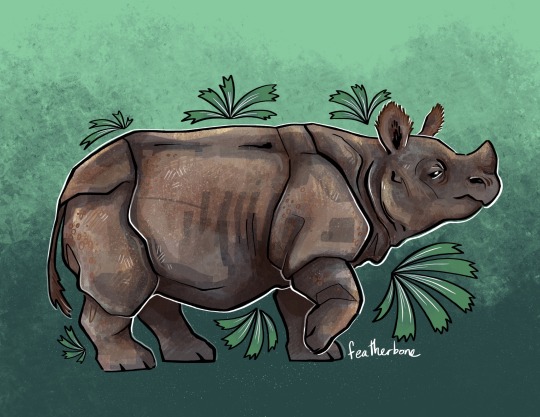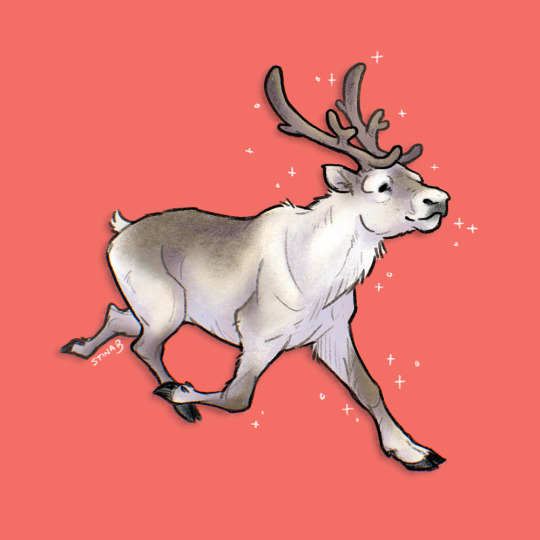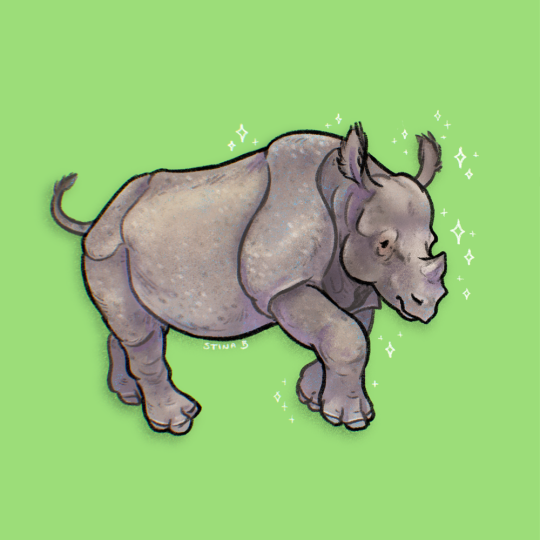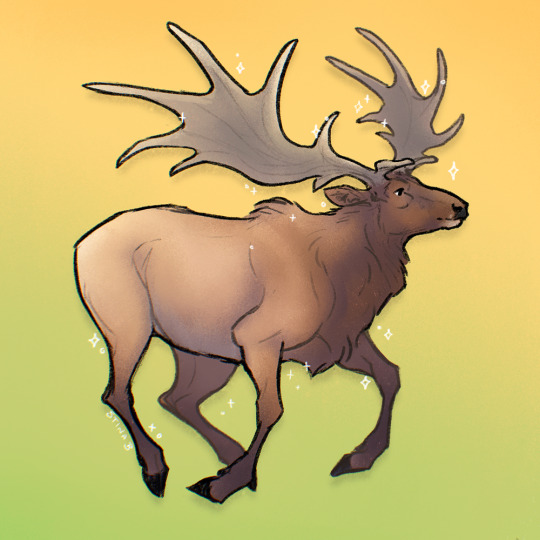#javan rhinos
Explore tagged Tumblr posts
Text

Javan rhinoceros. Last Chance on Earth; a Requiem for Wildlife. Roger A. Caras. Illustrated by Charles Fracé. 1966.
Internet Archive
132 notes
·
View notes
Text
Two pieces of good news for the Rhinos: a baby Javan Rhino (the most endangered) has been born!
Also, a two-year-old white rhino had a successful surgery on her broken foot.
#javan rhino#javan rhino calf#white rhino#endangered animals#endangered species#rhino#rhinoceros#good news#animals#animal news#endangered rhino
442 notes
·
View notes
Text

Hello! I'm so proud to finally present you the artwork with all the Perissodactyla order including its subspecies (Rhinos, Tapirs, and Horses). Took me more than a year to finish but I am really happy with the result. The artwork includes the common name, its Latin name, and its conservation status. 46 animals in total of which 10 are sadly already extinct.
Here is the link in case you are interested:https://www.inprnt.com/.../all-perissodactyla-species.../
Thank you for your support!
#black rhino#javan rhino#white rhino#sumatran rhino#rhinoceros#illustration#drawing#scientific illustration#plain zebra#zebra#wild ass#artist on tumblr#wildlife#illo#donkey#malayan tapir#tapir#artwork#unique prints#illustration scientifique
406 notes
·
View notes
Text

[ID: an illustration of a rhino facing to the right, with one foot raised slightly. It is surrounded by ferns on a forest green background. End.]
Javan rhinoceros! Once, they lived from northeast India to Southeast Asia - today they are one of the most endangered land mammals, with under 80 individuals left in Ujung Kulon National Park in Java, Indonesia.
315 notes
·
View notes
Text


bish bosh pt. 2
#joker out#bojan cvjetićanin#i need him protected like he's the last surviving javan rhino#*my gifs#bojan#*my post
107 notes
·
View notes
Text
#java#good news#rhino#java rhinoceros#javan rhino#environmentalism#science#environment#nature#animals#conservation
39 notes
·
View notes
Text

Javan rhinoceros Rhinoceros sondaicus sondaicus
Observed by roylesafaris, CC BY-NC
102 notes
·
View notes
Text




Wood Engraving Wednesday
Abigail Rorer
I have long been a fan of the work of Massachusetts wood engraver, letterpress printer, and book artist Abigail Rorer (b. 1949). A former student of Barry Moser and inspired by the work of Leonard Baskin, Rorer is a part of what I call the Pioneer Valley School of artists, an interconnected group of artists and artisans who live, work, or trained in the Connecticut River valley region of western Massachusetts, centered in the Amherst/Northampton area.
I am particularly interested in Rorer's attention to detail, precision of mark making, and her fine lines, all of which are evident in this lovely engraving of a Javan Rhinoceros (Rhinoceros sondaicus). The original, signed print is one of several prints included in the Wood Engravers' Network (WEN) 2022 Printers Bundles sent in the fall to WEN members along with that year's issue of the society's journal Block & Burin. An over 20-year run of both the journal and the bundles was recently donated to Special Collections by Wisconsin WEN member Tony Drehfal.
I selected this print to post not only because Rorer is one of my favorite wood engravers, but also because the rhinoceros is my very favorite mammal (they are exquisite and beautiful!) and it pains me how endangered all species of rhinos are around the world. This print may become among last visual representations of this magnificent being before it is erased from our planet, or more hopefully, it may be one of the images that marks the revival of Rhinocerotidae.

View more posts on work by Abigail Rorer.
View more engravings by members of the Wood Engraver’s Network.
View more posts with wood engravings!
-- MAX, Head of Special Collections
#Wood Engraving Wednesday#wood engravings#wood engravers#women wood engravers#Abigail Rorer#Wood Engravers' Network#WEN#Tony Drehfal#Javan Rhinoceros#Rhinoceros#Rhinos#WEN Printers Bundle#Pioneer Valley School
17 notes
·
View notes
Text
youtube
Javan Rhino
#blogger#writerslife#women writers#biodiversity#writerscommunity#writer things#articles#javan rhino#rhinoceros#wild animals#rhino#wildlife conservation#wildlife#Youtube
0 notes
Text
Ok but like every time I visit the Wikipedia page for one of the classic endangered animals it's almost always like "populations have increased by 20% in the last decade" and idk it really makes me feel like maybe things are gonna get better
#javan rhinos im so sorry#and white rhinos too#but tigers? giraffes? pandas? hell fucking yeah buddy
1 note
·
View note
Text

The Indian Javan Rhinoceros was often mistaken for the Greater one-horned Rhinoceros due to their coexistence in the 19th century. This can't happen to you. Join the club Here to learn more about animals. By the way, this is the only existing illustration of this animal.
#Indian Javan Rhinoceros#javan rhinoceros#Rhinoceros#rhino#rinoceronte#conservation#extinction#exotic animals#scientific illustration#illustration#wild animals#artist on tumblr#mammals#wildlife
38 notes
·
View notes
Text

The Critical Javan Rhinoceros - 8 x 10 - Acrylic on Canvas
Stay up-to-date on critically endangered species! The Javan Rhinoceros numbers continue to dwindle despite conservation efforts due to the animals' temperament both in and out of captivity. Fortunately, a calf was photographed in the wild just recently, giving many hope!
#alabaster raven illustrations#artists on tumblr#traditional art#original art#acrylic painting#acrylic on canvas#javan rhinoceros#javan rhino#critically endangered#conservation efforts
1 note
·
View note
Text
Creature Awaits #212
Each week I plan to feature an amazing creature, admiring God's fantastic artistry. Hopefully it’ll brighten someone’s day to see something new and interesting if they haven’t seen it before. : )

(Taken approx. 1900 A.D, Photographer Unknown (Public Domain Mark 1.0))
The Javan Rhino
Scientific Name: Rhinoceros sondaicus
Region: While their range used to spread from Bhutan and far east India southward through Java, Indonesia, they now only exist in a tiny region of western Java.
Size: About 10' (3m) long and 4.6'–5.6' (1.4m–1.7m) tall at the shoulder
Interesting Notes: Sadly, rarest of all 5 species of Rhinoceros, only about 60-70 are thought to be left in the wild - all located within the Ujung Kulon National Park in Java. They are so endangered that even scientists will rarely seek them out for study as they do not want to risk interfering as they, hopefully, start to regrow their populations. It's also a tricky situation as they do not hold up well in captivity - with the oldest attempted captive rhino living only to age 20, and none ever being able to breed. However, it's not all sad news… Thankfully, very strict conservation laws are finally in place for them, and they do appear to still be breeding in the wild as two adults walking alongside their calves were caught on a motion-triggered camera, so hopefully someday they will thrive again.
#creatureawaits#beautiful animals#endandered species#Javan Rhinoceros#Rhinoceros sondaicus#rarest Rhino#animals of Java#Indonesia
1 note
·
View note
Text














that's a wrap on ungulate june! thanks to followers on instagram who provided the suggested species for this little series 🦌
saiga antelope / fallow deer / markhor / caribou / javan rhino / takin / bighorn sheep / bongo / pronghorn / greater kudu / red deer / tibetan antelope / elk / megaloceros
659 notes
·
View notes
Text
Global rhinoceros numbers have increased to 27,000 despite populations being ravaged by poaching and habitat loss, new figures show, with some species rebounding for the first time in a decade. Rhinos numbered about 500,000 across Africa and Asia in the 20th century but their populations have been devastated. Last year, they began showing signs of recovery in some areas, although two species – the Javan and Sumatran – remain close to disappearing. Figures released by the IUCN African Rhino Specialist Group, the conservation body, indicate that the global rhino population increased to about 27,000 at the end of last year, with southern white rhino numbers increasing for the first time since 2012, from 15,942 at the end of 2021 to 16,803. In 2021, the world’s rhino population was estimated to be 26,272. Black rhinos, native to east and southern Africa, have been heavily depleted by poaching for their horns but last year increased by nearly 5%, rising from 6,195 at the end of 2021 to 6,487 at the end of 2022. This increase has happened despite a rise in black rhinos killed by poachers, and has been aided by conservationists establishing new populations that have grown in size.
Continue Reading
369 notes
·
View notes
Text

Javan rhinoceros Rhinoceros sondaicus sondaicus
Observed by roylesafaris, CC BY-NC
10 notes
·
View notes